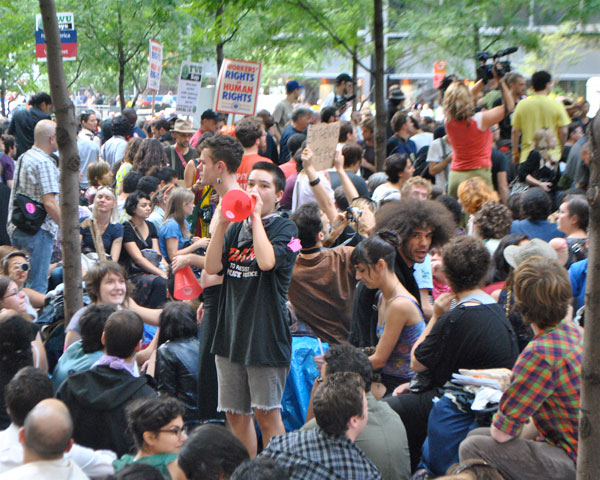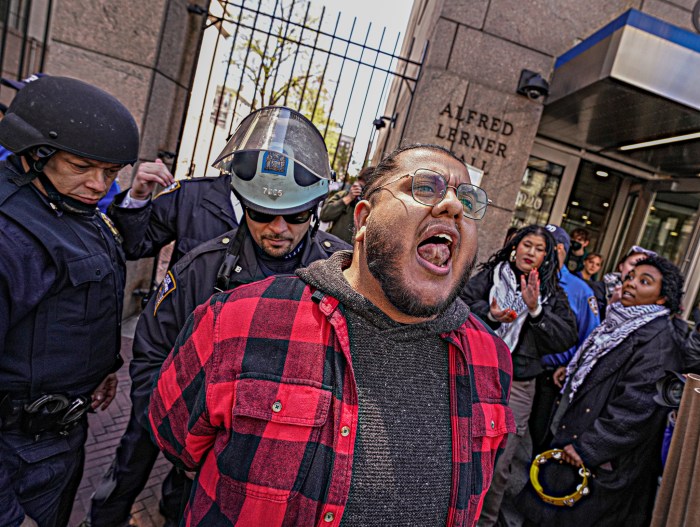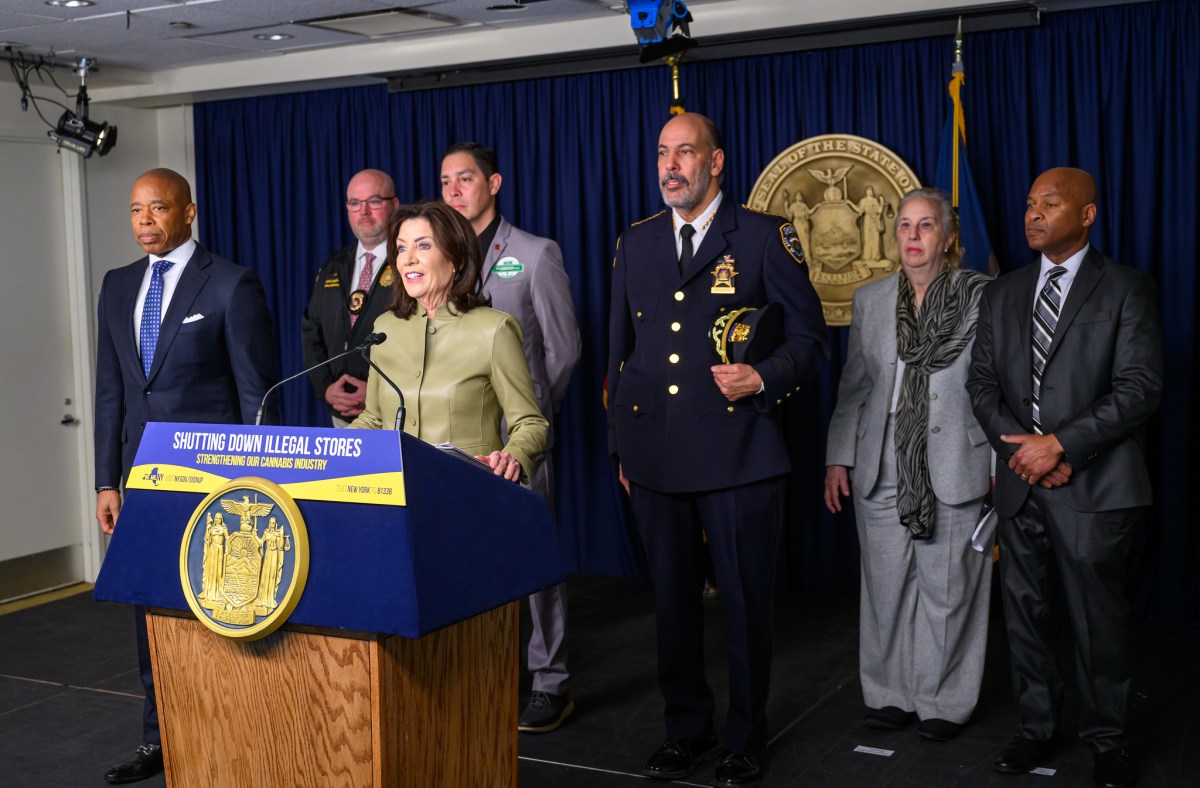 [/media-credit]
[/media-credit]
- In lieu of a traditional public announcement system, an Occupy Wall Street protester uses a small megaphone to relay a speaker’s words to the rest of the crowd in Zuccotti Park. The method has been dubbed “the people’s microphone.”
BY ZACH WILLIAMS | Occupy Wall Street is spreading beyond street demonstrations and into a niche a bit more close to home.
As the movement enters its third month, a new type of occupation is growing within American popular culture and is finding its way into all types of public forums, including Dept. of Education hearings in Lower Manhattan.
The ongoing demonstrations against corporate greed and government malfeasance have inspired a growing presence in common discourse, television, fashion, and online.
When a New York City political science professor could not catch the words of a soft-spoken student toward the back of the classroom, she decided to make a cultural reference which soon resonated with her students.
The professor asked for the “People’s Microphone” to be used. The device developed by occupiers has listeners repeat a speaker’s words in order to allow others further away to hear.
It may have been originally needed in order to circumvent New York City ordinances against electronically-amplified sound, but it now has found a purpose elsewhere.
The technique is just one of many features derived from Occupy Wall Street which have extended their reach beyond activist circles and into the wider realm of popular culture in the city and throughout the country.
But in a movement that has directed considerable energy towards protesting the excesses of American consumers as well as corporate executives, the mediums of exposure are a mixed blessing, according to the activists.
Occupier Rose Reddington, 22, said the growing profile of the movement in popular culture had to be taken in stride since it could ultimately help the movement reach a wider segment of society.
“They had those t-shirts with the ‘Occupy Wall Street’ message on it. I ground my teeth but at the same time its important for other kids to ask ‘What is Occupy Wall Street?’ and the wearer says ‘Sit down and I’ll tell you,’” said Reddington. “The success of a movement is all about being co-opted. That’s what happened to flower power; it suddenly became cool to be a hippie.”
Among the most emblematic features of the movement, “Mic check” has allowed activists to find a new method for airing their grievances against political elites or to simply convey their message in forums where they typically feel left out. What started as a phrase indicating a desire to speak among peers became a device of protest itself, where by activists interrupt a speaker by repeating a prearranged statement in unison.
Political figures such as President Obama, Karl Rove, and presidential candidates Michelle Bachman and Ron Paul have all been the targets of “Mic checks” in recent weeks.
Reactions have been mixed among them with Obama and Paul allowing the protesters to speak, Rove confronting them from the podium and Bachman leaving the venue. Online videos of the encounters meanwhile went viral.
“Do you feel better?” Paul said in response to the interruption at a Nov. 21 townhall meeting in Keene, New Hampshire.
Throughout the web and television, references to the protests continue to pervade news stories. Actions taken by law enforcement across the country against “Occupy” demonstrators have only increased its profile in popular culture in addition to keeping the movement in the headlines.
After University of California Police Lieutenant John Pike “casually” pepper sprayed non-violent protesters who refused to disperse during a Nov. 18 demonstration at U.C. Davis, a video of the incident gained millions of views on YouTube within hours. Ensuing outrage preceded the suspension of the police officer pending further investigation.
The incident also inspired a popular picture series online featuring the officer in such iconic images as The Beatles “Abbey Road” album cover and Associated Press photographer Nick Ut’s 1972 Pulitzer Prize-winning photo of a little girl crying in the streets following a napalm attack during the Vietnam War.
But comedy soon followed more serious forms of coverage as the means through which millions of people are being exposed to the movement.
Saturday Night Live is only one among several high-profile television shows to find rich material for satire in the ongoing protests. The animated series South Park recently devoted a full episode to a parody of the movement complete with multiple insertions of slogans such as “We are the 99 percent.”
In the episode, an overweight regular character named Cartman becomes the target of peers when his poor fitness scores require his classmates to replace recess with additional physical education classes. The police and the media meanwhile fixate on a supposed “occupation” in South Park.
Some New Yorkers said such satire underscores the increasing need for the movement to form a more cohesive political message lest it end up becoming “the butt of a joke”.
One corporate lawyer, who asked for his name not to be published because he didn’t want his employer to know he spoke with the media, said he was sympathetic to the movement. He added that it has the potential to be a catalyst for big changes in the country but could just as easily become irrelevant as time passes.
“The problem that I have with Occupy Wall Street is that it over-simplifies complicated issues and risks essentially turning everything into a cartoon character of itself,” he said. “I don’t want to see important messages get lost in the joke.”
Some attempts to capitalize on Occupy have been openly criticized by activists. The rapper and entrepreneur Jay-Z planned to spread the message of the movement as well as turn a personal profit by selling t-shirts featuring the slogan “Occupy Wall Street” through his Rocawear clothing line.
Following the backlash, the clothing line released a new version. The “W” was crossed out and an “S” added to the end. “Occupy all streets,” the t-shirts now read above the designer label.
Some outside the movement said its lasting footprint within the American cultural landscape will continue to grow, but only once more artists draw inspiration from its message and commercial references to its slogans portray the movement in a more positive light.
“When those things get involved and that takes time,” said Jay Nieves. 23, of Brooklyn who said he has declined online invitations on Facebook to join the movement, “you’ll see a bigger impact.”

















